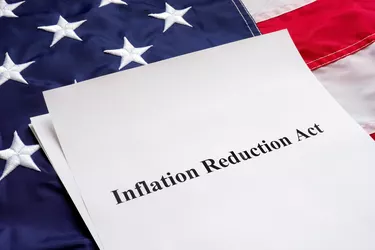
The Inflation Reduction Act of 2022 has been in the news a lot lately. Its enticing name draws attention at a time when Americans are facing a 9.1 percent increase in consumer prices. While fiscal policy tends to become politicized, it's helpful to break this budget reconciliation bill down to basics to understand why it's being talked about and how it affects you and your personal finances.
The Inflation Reduction Act Explained
Video of the Day
The Act is comprised of spending and tax incentives and reforms that aim to reduce the deficit, fight inflation and support domestic energy and clean energy. Five main pieces of the bill predict a combined $300 billion reduction in the deficit over the next 10 years.
Video of the Day
- Affordable Care Act (ACA) extension: The bill puts forth $64 billion in subsidies to lock in lower health care premiums through 2025 by extending the premium tax credits due to expire at the end of 2022.
- Medicare prescription price reforms: The package allows Medicare to negotiate lower prescription drug prices, redesigns Medicare Part D and sets a yearly cap of $2,000 on out-of-pocket drug costs for Americans covered by Medicare. The estimated revenue generation for this reform is $288 billion, and the average savings is anticipated to be $800 per year for 13 million Americans.
- Clean energy, energy security and climate change: The Act invests $369 billion to support an estimated 40 percent reduction in greenhouse gas emissions by 2030, clean energy technology, renewable energy, energy efficiency and related tax incentives for American households and businesses.
- Corporate minimum tax: The Act puts a minimum 15 percent tax rate on corporations with a book income of $1 billion or more and closes the carried interest loophole for investment fund managers. Tax increases would apply to households with an annual income above $400,00 and are estimated to bring in revenue of $313 billion over the next 10 years.
- Increased IRS funding: To support the ability of the IRS to conduct more audits and enforce the bill's tax reforms, IRS funding would increase by $124 billion.
What the Act Costs Americans
The summary issued by the Democrats who proposed the bill provides individual estimates for each significant part of the bill.
Estimates are furnished by the Joint Committee on Taxation (JCT) and the nonpartisan Congressional Budget Office (CBO) to approximate revenue raised, total investment and deficit reduction.
Overall investments in the Inflation Reduction Act's initiatives total $433 billion, and projected revenue totals $739 billion, resulting in an estimated deficit reduction of over $300 billion.
While the closing of tax loopholes does involve raising taxes, economists and Secretary of the Treasury, Janet Yellen, have made efforts to emphasize who the tax portion of the bill impacts: taxpayers with an annual household income over $400,000 and very large businesses with over $1 billion in book income.
Lower costs for prescription drugs, affordable healthcare premiums, reduced energy costs and a $7,500 tax credit for electric vehicle owners are examples of short-term benefits for American consumers.
What the Act Saves Americans
The Inflation Reduction Act sections are meant to work together to reduce inflation and reduce pressure on consumers. In addition, each individual category of the bill has the potential to save American taxpayers in the short and long term.
Lower costs for prescription drugs, lower health care premiums, reduced energy costs and a $7,500 tax credit for electric vehicle owners are examples of short-term benefits for American consumers struggling with rising costs.
Benefits for businesses may include grants and rebates to increase domestic manufacturing of clean energy, tax credits for reducing carbon emissions and leveling the playing field for small businesses by taxing big businesses.
Long-term benefits include a reduction in America's dependency on fossil fuels, an increase in clean energy and a focus on legislation that works to solve the climate crisis for future generations.
Who Proposed the Act?
The Biden Administration proposed the $1.7 trillion Build Back Better Act in 2020-21 as a socially focused economic framework to rebuild the middle class, meet climate goals and grow the post-pandemic economy. Republicans opposed the framework, and not all Democrats agreed on it, either. The bill couldn't make it to the Senate floor.
In July 2022, Senate Democrat Joe Manchin of West Virginia and Senate Majority Leader Chuck Schumer brought forward the Inflation Reduction Act, issuing a joint statement of their support. The Act has some of the same initiatives and provisions but with a trimmed-down cost. President Joe Biden also gave remarks on his support of the Act.
Will Inflation Reduction Act Work?
While the contents and goals of the Inflation Reduction Act are the same, no matter who is reporting on them, it is up for debate whether those goals are accomplished through the Act.
The Penn Wharton Budget Model and the Tax Foundation concluded that the bill would have a minimal or negative effect on inflation. At the same time, the AFL-CIO and Roosevelt Institute support its inflation-fighting potential, and more than 125 leading economists signed a letter to Congress supporting the legislation and its anticipated impact.
- Senate Democratic Majority: Inflation Reduction Act: One-Page Summary
- WhiteHouse.gov: Remarks by President Biden on the Inflation Reduction Act of 2022
- Committee for a Responsible Federal Budget (CRFB): What Is the Inflation Reduction Act?
- Letter From Economists to Congressional Leadership
- Details & Analysis of the Senate Inflation Reduction Act Tax Provisions
- U.S. Department of the Treasury: Secretary of the Treasury Janet L. Yellen: Inflation Reduction Act Won’t Raise Taxes on Families Earning Less Than $400,000/Year
- AFL-CIO: 8 Ways the Inflation Reduction Act Helps Working People